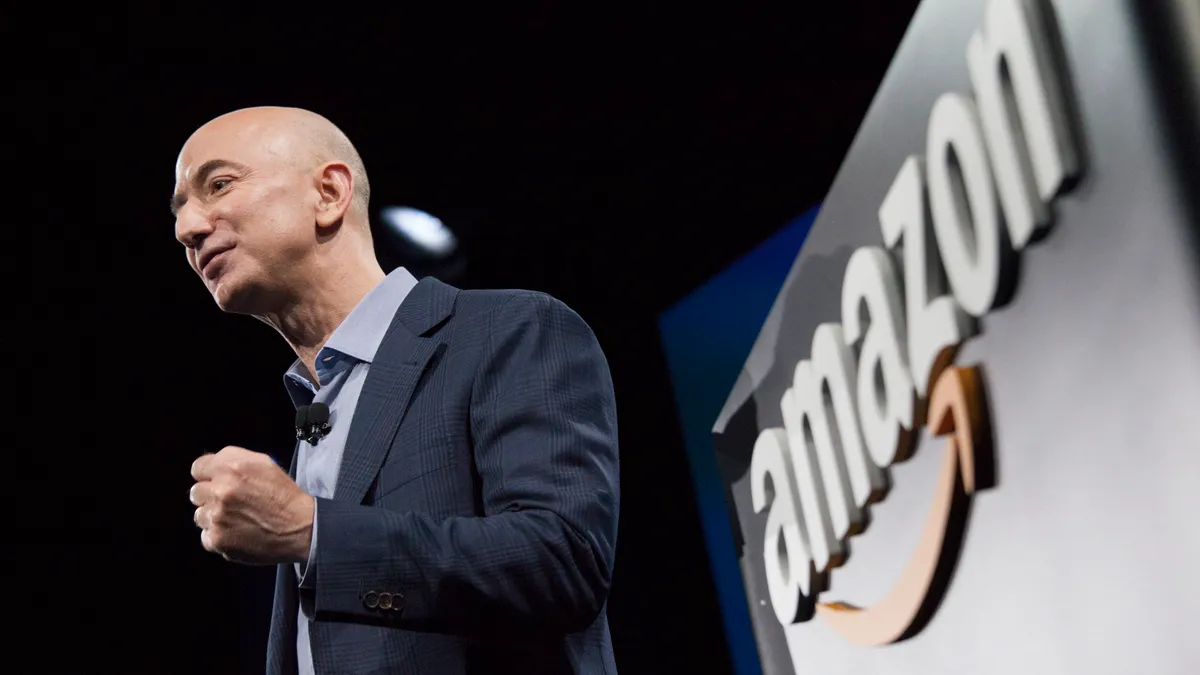Dive Brief:
-
Amazon.com, Inc. swooped past expectations Thursday evening with its eighth straight quarter of turning a profit: Q1 net income rose 41% to $724 million (or $1.48 per share), handily beating expectations from Thomson Reuters I/B/E/S analysts cited by Reuters for $1.12 per share — a leap over last year’s Q1 net income of $513 million, or $1.07 per share.
-
Q1 net sales increased 23% to $35.7 billion, compared with $29.1 billion in the same period last year. Excluding the $492 million in unfavorable impact from year-over-year changes in foreign exchange rates throughout the quarter, net sales increased 24% compared with Q1 2016. Q1 net sales in North America rose 23.5% to $20.99 billion.
-
Amazon made special note of its accomplishments abroad, particularly in India. Amazon introduced the all-new Fire TV Stick in India with new features optimized for customers there, including voice search in Hindi, free data for three months, data monitoring, and a “vast selection” of local and global movies and TV shows. The Fire TV Stick also launched in the U.K., Germany, and Japan, the company said.
Dive Insight:
Although it continues to plow revenues back into investments — including a number of experiments that really never pan out — Amazon has been setting many investors’ minds at ease in recent quarters, all thanks to the steady profits contained in its reports. After reporting earnings, Amazon stock jumped nearly 4% in after-hours trading.
“Amazon’s Q1 results reflect continuing short-term investment in longer-term initiatives, which we believe is a solid strategy, with credit support provided by the company’s robust liquidity profile,” Moody’s Lead Retail Analyst Charlie O’Shea said in a note emailed to Retail Dive.
In Q1, Amazon seems to have mitigated its shipping cost problem, which dragged down results in the third quarter last year. That's thanks to growth in Prime memberships (and their attendant fees), particularly in North America, noted GlobalData Retail managing director Neil Saunders. “Unfortunately, such a pattern was not replicated on the international front, where an unfavorable exchange rate plus extensive investments in new services and initiatives dramatically increased operating losses,” Saunders wrote in a note emailed to Retail Dive.
Of graver concern is that Amazon is increasingly feeling the pinch of competition from a newly ambitious Wal-Mart's e-commerce play as well as other traditional retailers boosting their e-commerce sales, Saunders said.
Amazon has time — maybe two to three years — to address increased competition, according to Keith Anderson, VP of strategy and insights at retail intelligence firm Profitero. “I don’t think there’s any way over the immediate term, even with the aggressive policies that [Jet founder and Wal-Mart e-commerce chief] Marc Lore and Wal-Mart are introducing, that Wal-Mart is going to be disruptive overnight to Amazon’s business — with the exception of pricing. You have to remember that Amazon’s still outpacing [everyone], and they’re by far the biggest player in the market. Margin compression is the biggest near-term risk.”
The first quarter already indicates a slower pace of growth for Amazon, according to Saunders. That will continue to challenge Amazon in North America, and it puts more pressure on the company to address its weaknesses.
Much of Amazon's strength will be found abroad, Natalie Kotlyar, leader of consultancy BDO’s Consumer Business practice, told Retail Dive. “Obviously they’re looking to grow their international sector because the real way to grow is internationally. There’s certainly a lot of investment going into India, and they’re focused there given the sheer size of India and the number of people there. Amazon seems to fully invest in a venture that they feel will be profitable, and given the potential in India, they’re going in full force.”
If Amazon is to grow internationally, though, it probably needs a stronger commitment in some countries, according to Profitero's Anderson. “Amazon hasn’t dominated any international market to the extent they have in the U.S.,” he told Retail Dive. “They haven’t fully deployed all of the programs and services internationally that they have in the U.S. — the device eco-system or the content. But even more than that, they haven’t released Prime in every country, or Subscribe and Save or Prime Pantry. When you look at 24% growth in North America and 16% international, that suggests to me they still need to find a more compelling platform for growth ex-U.S.”
But Amazon is in something of a catch-22: The e-commerce giant may need international expansion to balance slowing demand at home, but it needs strength at home to cover the expenses of investments abroad. Amazon’s Echo devices — its Alexa voice assistant and new “Echo Look” video technology — will enable such efforts, Saunders said.
“Against this backdrop, it is essential that Amazon maximizes its potential in areas and categories where it is currently underweight,” Saunders said. “This includes fashion, where we are encouraged by the new development of private labels such as Goodthreads and Lark & Ro. Although these are embryonic, they provide Amazon with the building blocks to develop a much more compelling, and slightly higher-margin, fashion proposition which will help it to grab market share profitably.”
When it comes to grocery — into which the company appears to moving full steam ahead with pilot brick-and-mortar stores — Amazon is entering more of a quagmire, a difficult retail sector beset by thin margins and complicated operations. “As much as we are encouraged by Amazon's drive into categories like fashion and home, we are more hesitant about the Amazon Fresh business,” Saunders noted. “As much as we believe this has solid long-term potential, we think the logistical complexities and the low margin nature of grocery mean that it will be an expensive drag on profits for the foreseeable future.”












